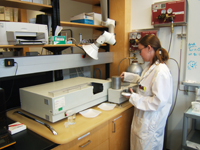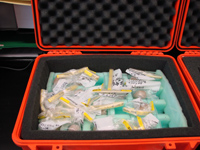Laboratories and research support: laboratory services
| Article Title |
|---|
Laboratory Services |

The Laboratory Services Section provides advice and support to wildlife and landscape scientists.
Current expertise includes the analysis of biological material - mainly avian tissues - for residues of Persistent Organic Pollutants (POPs), emerging organic contaminants, trace metals, and biomarker measurements as indicators of environmental contamination and early warnings of potential health issues.
The laboratories are accredited by the Canadian Association for Laboratory Accreditation (CALA) to the ISO/IEC 17025:2005 standard. Accreditation is limited to the scope indicated for Laboratory Services (National Wildlife Research Centre) in the CALA Directory of Laboratories. Laboratory Services regularly participates in inter-laboratory studies, including the Northern Contaminants Program (NCP) and Arctic Monitoring and Assessment Programme (AMAP) interlaboratory study managed by ECCC’s Information and Quality Management group.
Current Research and Methodology
Sample Preparation and Specimen Banking
-
Reception of tissues from approximately 3,000 specimens per year

- Division of organs to sub-samples and subsequent cataloguing and storage
- Homogenization of samples
- Preparation of pooled samples
- Morphometric measurements
- Eggshell thickness determination
- Preparation of in-house reference materials used for quality assurance and quality control of trace chemical analysis
- Encapsulation of samples for stable isotope analysis
- Management of the National Wildlife Specimen Bank
Analytical Services
-
Mercury by Direct Mercury Analyzer (DMA-80) and methylmercury by gas chromatography cold-vapor atomic fluorescence spectroscopy (GC-CVAFS)

- Trace elements by inductively coupled plasma mass spectrometry (ICP-MS)
- Ultra trace analysis of persistent organic pollutants (POPs) and emerging compounds - chlorinated pesticides, organic contaminants, polychlorinated biphenyls (PCBs), brominated flame retardants (BFRs) and polybrominated diphenyl ethers (PBDEs) by gas chromatography mass spectrometry (GC-MS)
- Fatty acid methyl esters (FAMEs) by gas chromatography flame ionization detector (GC-FID)
- Perfluoroalkyl substances (PFAS) by liquid chromatography mass spectrometry (LC-MS)
- Pesticides (neonicotinoids, herbicides, rodenticides) by liquid chromatography mass spectrometry (LC-MSD)
- Biochemical biomarkers including:
- thyroid function - TT3, TT4
- enzymatic activity measurements - ethoxyresorufin-O-deethylase (EROD)
Advice to Customers and Academia
-
specimen sampling, preservation, storage, and shipping procedures

- analytical techniques (may include training sessions)
- import and export transportation regulations for wildlife specimens
- capabilities of private sector laboratories: assessment of data on in-house reference material and on standard reference material (SRM) for OC/PCBs and dioxins analysis
- method development and adaptation
Experts in Laboratory
- Emily Porter, manager
- Robyn Lima, quality assurance
- Bridget Enright
- Lewis Gauthier
- France Maisonneuve
Further Reading
- National Wildlife Specimen Bank, Environment and Climate Change Canada
- Canadian Association for Laboratory Accreditation